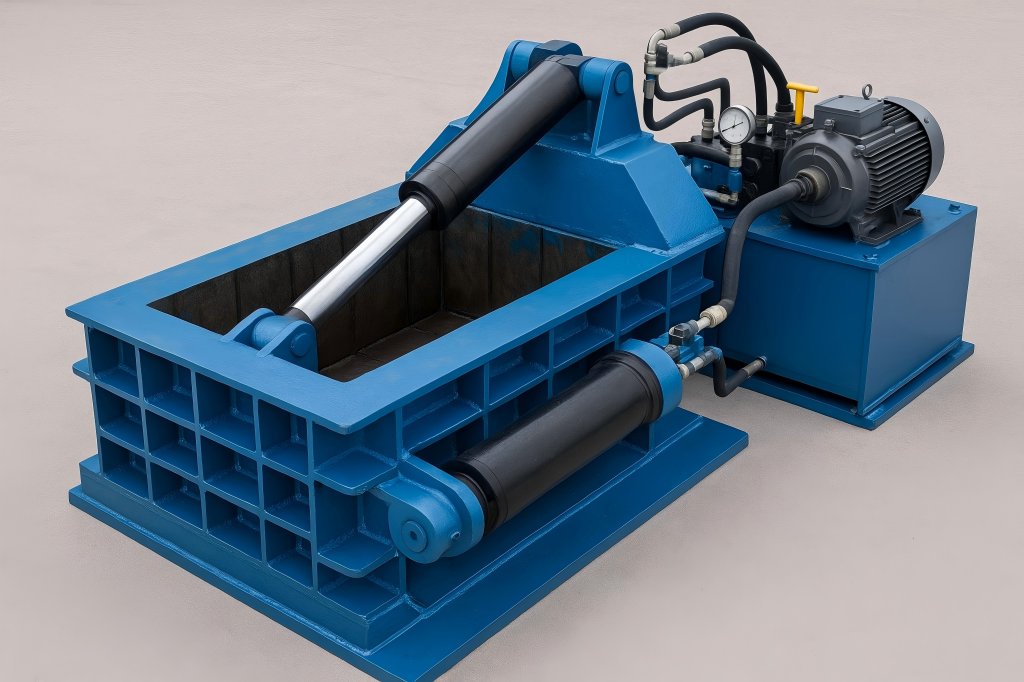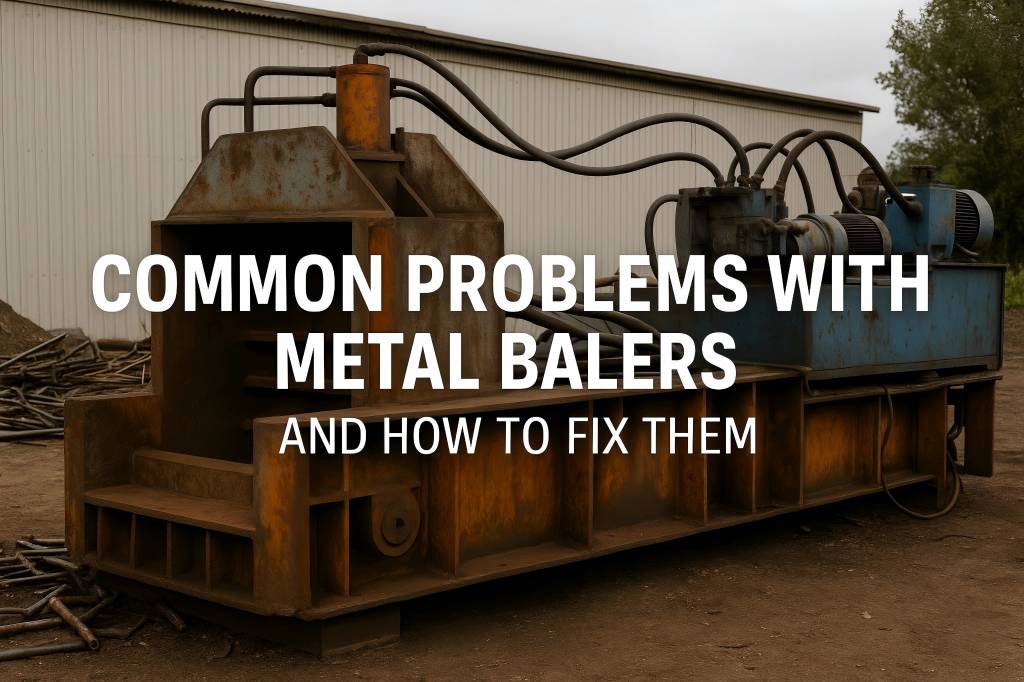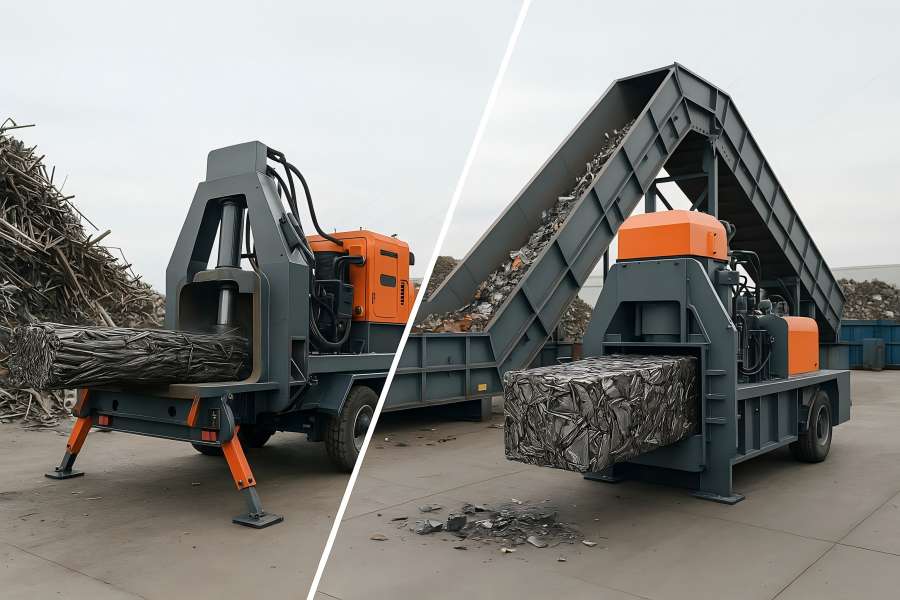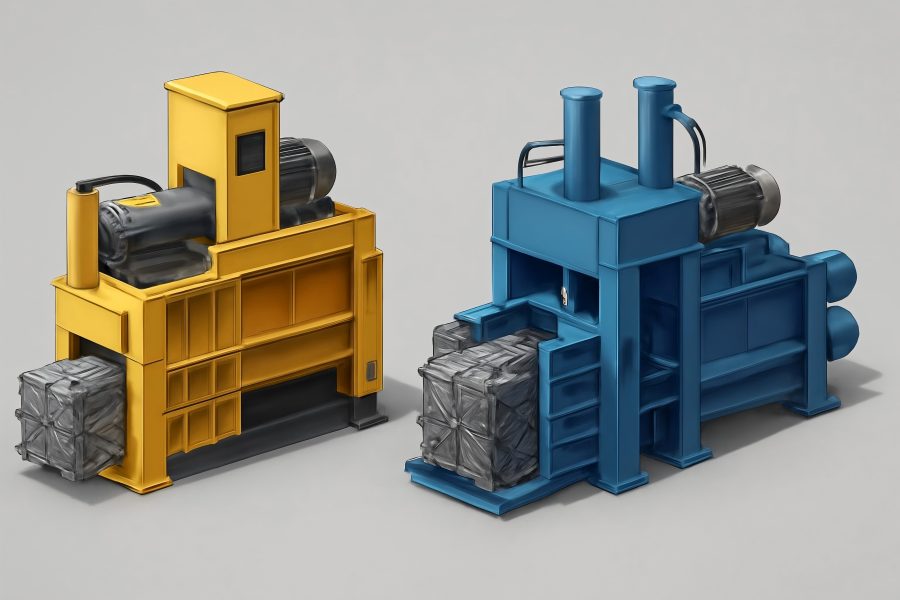Metal balers are essential in modern scrap processing and recycling operations, but like any heavy machinery, they are not immune to technical setbacks. If not identified and fixed right away, even small problems can grow into significant disruptions.
This article delves into the most common problems faced by metal balers and offers practical strategies for troubleshooting and repair.
Hydraulic System Failures: Causes and Repair Strategies
Hydraulic systems are the heart of any metal baler. They power the compressing and ejecting mechanisms through fluid pressure, ensuring seamless operation. When failures occur in the hydraulic circuit, the machine can experience slow cycles, complete inactivity, or erratic movements.
Common Causes:
- Fluid Leaks: Considerable pressure loss may result from damaged hoses, seals, or connectors.
- Pump Failure: A malfunctioning hydraulic pump reduces flow rate and pressure, often due to cavitation or wear.
- Overheating: Excessive heat from continuous operation or inadequate cooling systems can degrade hydraulic fluid and components.
- Contaminated Fluid: Dirt, water, or metal particles in the hydraulic oil can clog filters, damage valves, and erode system efficiency.
Repair Strategies:
- Check and Replace Seals: Check for wear or damage on a regular basis on hoses, fittings, and seals.
- Pump Maintenance: Listen for whining noises or excessive vibration. Replace or rebuild faulty pumps based on OEM guidelines.
- Flush and Refill: Periodically flush the hydraulic circuit to eliminate contamination and replace it with clean, manufacturer-approved fluid.
- Cooling System Inspections: Verify that the fluid coolers, fans, and radiators are clean and in working order.
Electrical Malfunctions and Control Panel Issues
The control system governs the logic and sequence of baler operations. Electrical faults can manifest as unresponsive buttons, inconsistent motor starts, or intermittent signal errors.
Common Causes:
- Worn Contacts and Relays: Frequent arcing or overload conditions degrade contact points.
- Sensor Failures: Proximity or limit switches may send incorrect signals or none at all.
- Wiring Faults: Loose connections, damaged insulation, or rodent damage can interrupt electrical flow.
- PLC Errors: Corrupted programming or voltage spikes can disrupt Programmable Logic Controller (PLC) operations.
Repair Strategies:
- Regular Panel Inspection: Tighten connections and check for burnt relays or corroded terminals.
- Sensor Calibration: Replace misaligned or failed sensors and recalibrate them as per manufacturer instructions.
- Wiring Tests: Use a multimeter to check for continuity and resistance. Replace damaged cables.
- PLC Diagnostics: Access diagnostic tools to detect fault codes. Backup and reload program firmware if required.
Wear and Tear on Moving Parts and Seals
Mechanical degradation is inevitable in high-force operations. Over time, the repetitive motion of baling leads to friction, metal fatigue, and material loss.
Common Causes:
- Ram Guides and Tracks: Continuous sliding motion causes scoring and misalignment.
- Seals and Bushings: High pressure and abrasion lead to leaks and reduced mechanical integrity.
- Bearings and Shafts: Overloaded bearings can seize, while unlubricated shafts may warp or break.
Repair Strategies:
- Routine Inspections: Monitor for unusual noises, vibration, or slack in moving parts.
- Replace Components on Schedule: Adhere to the OEM replacement cycle for seals, gaskets, and bushings.
- Apply Anti-Wear Coatings: Use protective coatings or inserts on contact surfaces to extend lifespan.
- Lubrication Routines: Establish a strict lubrication schedule using the correct grease or oil grades.
Bale Ejection Failures and Jammed Cylinders
A metal baler’s productivity relies on smooth bale ejection. When the ram or ejector cylinder jams, production grinds to a halt, often damaging internal components.
Common Causes:
- Improper Material Loading: Overfilling or uneven load distribution puts stress on the ejector system.
- Hydraulic Imbalance: Unequal pressure distribution in double-acting cylinders.
- Foreign Object Obstruction: Residual scrap or non-metallic debris caught in the ejection path.
Repair Strategies:
- Check Pressure Balance: Verify both ports of the cylinder receive appropriate pressure using hydraulic gauges.
- Clear the Ejection Channel: Shut down and manually remove any obstructions or compacted material.
- Examine Cylinder Rods: Check for scoring or bending that could hinder smooth operation.
- Load Evenly: Train operators to distribute material uniformly within the compression chamber.
Inconsistent Bale Density or Shape
Inconsistent bales can affect downstream handling, transport costs, and buyer acceptance. This issue may stem from mechanical, hydraulic, or operational errors.
Common Causes:
- Pressure Drop: Inadequate hydraulic force leads to under-compacted bales.
- Worn Compression Plates: Deformed plates create irregular bale shapes.
- Improper Tying Mechanism: Loose wires or malfunctioning tying systems fail to hold bales tightly.
Repair Strategies:
- Monitor Hydraulic Output: Use pressure sensors to verify target compaction levels are met.
- Check Plate Alignment: Inspect and replace warped or misaligned platen surfaces.
- Tying System Maintenance: Clean and lubricate wire feed systems. Replace broken knots or tensioners.
Oil Contamination and Poor Lubrication
Oil is both a power transmission and lubrication medium in balers. Contaminated oil or inadequate lubrication accelerates part failure and reduces machine efficiency.
Common Causes:
- Water Ingress: Condensation or seal leaks can introduce water into the hydraulic oil.
- Metal Shavings: Wear particles from frictional surfaces degrade oil quality.
- Neglected Oil Changes: Old oil loses viscosity and chemical stability.
Repair Strategies:
- Implement Oil Analysis: Regularly test oil for contamination, viscosity, and wear metals.
- Replace Filters Frequently: Don’t wait for clogs. Follow a proactive replacement schedule.
- Seal Integrity Check: Inspect cylinder seals, tank gaskets, and breathers for breaches.
- Proper Storage: Keep lubricants out of the way of moisture and dust in dry, sealed spaces.
Overheating During Extended Operation
Excessive heat can cause hydraulic fluid breakdown, component expansion, and safety hazards. Identifying root causes early is crucial.
Common Causes:
- High Ambient Temperatures: Hot work environments exacerbate thermal buildup.
- Insufficient Cooling Capacity: Undersized or malfunctioning heat exchangers and fans.
- Continuous Duty Without Breaks: Extended runs without cooldown intervals.
Repair Strategies:
- Upgrade Cooling Systems: Install larger radiators or additional fans where needed.
- Reduce Cycle Frequency: Add intermittent pauses or shift operation to cooler hours.
- Monitor Temperature in Real-Time: Install thermal sensors and alarms to warn of overheating.
- Use Heat-Resistant Oils: Select hydraulic fluids with higher thermal stability ratings.
Safety System Failures and Operator Hazards
Injury prevention measures include interlocks, guards, and emergency stops. Their failure puts operators and the machine at serious risk.
Common Causes:
- Bypassed Interlocks: Temporary overrides that were never reset can leave the machine vulnerable.
- Faulty Emergency Stops: Physical wear or wiring issues prevent the button from triggering shutdown.
- Uncalibrated Safety Sensors: Sensors may fail to detect unsafe conditions or movement.
Repair Strategies:
- Regular Safety Audits: Conduct monthly inspections of all safety devices and documentation.
- Train All Operators: Ensure users understand the importance of every safety component.
- Replace Safety Devices Promptly: Never delay the repair or replacement of compromised safeguards.
- Install Redundant Systems: Consider dual-sensor configurations for critical zones.

Preventive Maintenance: Your Best Defense
Most baler problems can be avoided with a well-structured maintenance program. Potential problems are found through preventive maintenance before they become more serious.
Key Practices:
- Daily Visual Inspections: Check for leaks, loose bolts, and abnormal sounds.
- Weekly System Tests: Examine pressure levels, fluid clarity, and motor performance.
- Monthly Deep Checks: Inspect electrical panels, test safety interlocks, and clean internal components.
- Maintenance Logs: Keep a detailed record of service intervals, part replacements, and technician notes.
Long-Term Benefits:
- Increases equipment lifespan
- Minimizes costly unplanned downtime
- Improves resale value of the machine
- Enhances operator confidence and safety
When to Call a Technician: Knowing Your Limits
While many issues can be solved in-house, some problems demand professional expertise. Ignoring this can result in further damage or voided warranties.
When to Call for Help:
- Unidentified Faults: If the problem cannot be fixed by ordinary troubleshooting.
- Repeated Failures: Recurring malfunctions suggest deeper systemic issues.
- Complex Diagnostics Required: Advanced testing tools or programming updates may be needed.
- Warranty Considerations: OEMs may require certified technicians to conduct specific repairs.
Choosing the Right Technician:
- Look for experience with your baler brand or model
- Check for certifications and references
- Ensure they carry the right diagnostic equipment
- Clarify pricing and repair timelines in advance




